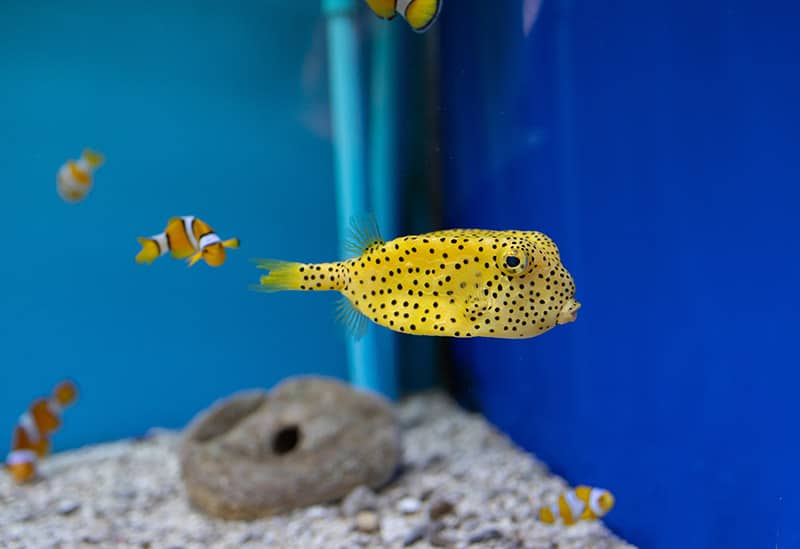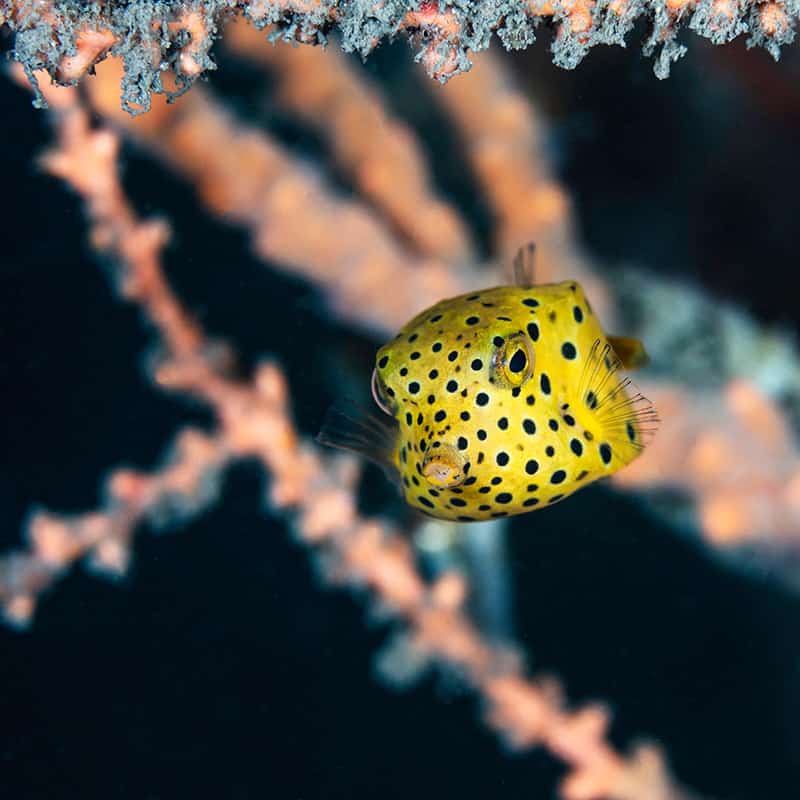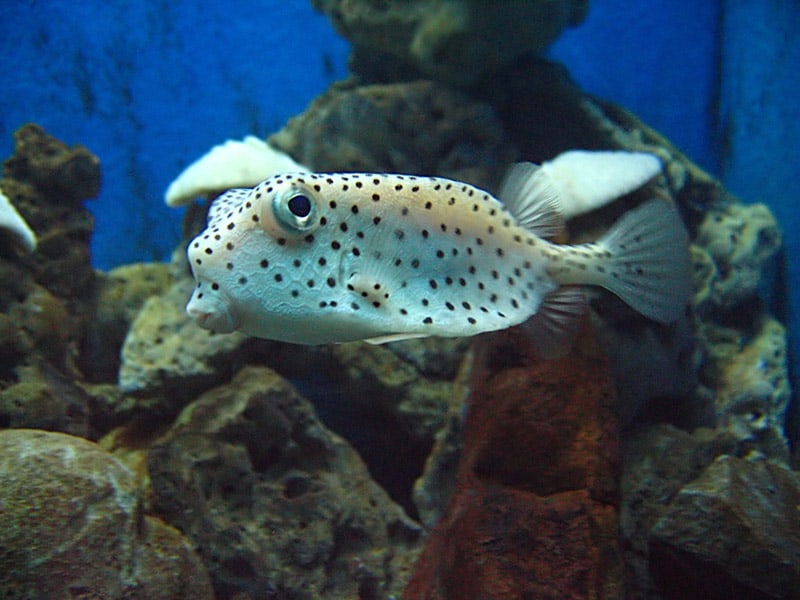This is a juvenile Polka-dot Boxfish, Yellow Boxfish, or Blue-spotted Boxfish. It’s so cute! Amazingly, this little fellow will grow up to be an adult thats 18 inches (45 cm)!
The Polka-dot Boxfish, Yellow Boxfish, or Blue-spotted Boxfish has an almost perfectly shaped cube for a body. It is yellow or cream colored with dark-blue spots. As they grow older the body becomes more elongated and the color can change to different colors, but mainly a yellow-green. The spots turn white with blue rings around them.
- For more information on keeping this fish see: Guide to a Happy, Healthy Marine Aquarium
Scientific Classification
| Kingdom: | Animalia |
| Phylum: | Chordata |
| Class: | Actinopterygii |
| Order: | Tetraodontiformes |
| Family: | Ostraciidae |
| Genus: | Ostracion |
| Species: | cubicus |

Maintenance difficulty
The Polka-dot Boxfish, Yellow Boxfish, or Blue-spotted Boxfish is easy to keep. Boxfish are not challenging if you feed young specimens several times a day. Start with brine shrimp.
The puffer’s teeth will continually grow throughout its life so you will need to supplement their diet with some hard shelled foods. Occasionally offering foods such as live ghost shrimp and various live snails will keep their teeth worn down.
Maintenance
Feed all kinds of live and frozen foods. Best to feed small amounts several times a day. We generally feed squid, shrimp (the same kind people eat), mussels, and all kinds of chopped up fish. Be sure to wash these foods thoroughly before feeding. Live fish will also be taken but should not be fed exclusively.
Habitat: Natural geographic location
Polka-dot Boxfish, Yellow Boxfish, or Blue-spotted Boxfish are found in the Indo-Pacific: Red Sea and East Africa to the Hawaiian and Tuamoto islands, north to Ryukyu Islands, south to Lord Howe Island. The Red Sea population differs slightly in coloration and has been known as Ostracion argus; closely related to Ostracion immaculatus from southern Japan. Southeast Atlantic: south coast of South Africa. Inhabits lagoon and semi-sheltered seaward reefs. Juveniles often among Acropora corals. Solitary. Juveniles expatriating to subtropical zone from the pelagic larval stage. Small juveniles secretive in narrow crevices. Occurs near shore in rock bottoms.
Foods
In the wild this boxfish feeds primarily on algae with a compliment of microorganisms, invertebrates, mollusks, sponges , sand dwelling polychaetes, crustaceans, foraminiferans, and small fishes.
In the aquarium you should feed all kinds of meaty foods and greenstuffs. A bottom feeder. Puffers are primarily predatory fish in the wild though they do graze on a bit of algae. This puffer will enjoy all kinds of meaty foods including shrimp, worms, clams, various mussels, snails, tunicates, and fish. They are not picky eaters and will quickly become adapted to a variety of prepared aquarium foods and an occasional algae wafer. Flake food is not recommended. Even though they may eat it, puffers will not thrive on it.
Social Behaviors
Apparently this fish is sometimes aggressive and sometimes not. Keep an eye on newcomers with an established boxfish and any new boxfish that are added to the aquarium.
Sexual differences
Apparently many boxfish are easy to sex but we haven’t found this information yet.

Recommended light levels
Temperature
No special requirements. Normal temperatures for marine fish is between 74 and 79 degrees Fahrenheit.
Length/Diameter of fish
Polka-dot Boxfish, Yellow Boxfish, or Blue-spotted Boxfish adults can grow to 45.0 cm (18 inches).
Minimum Tank Length/Size
A minimum 100 gallon aquarium is recommended.
Water Movement: Weak, Moderate, Strong
Water Region: Top, Middle, Bottom
Availability
This fish is available from time to time.
- Beginner Fish – Saltwater fish for beginners
- Community Fish – Peaceful Saltwater fish
- Hardy Fish – Hardy Saltwater fish
Featured Image Credit: summer, Shutterstock
